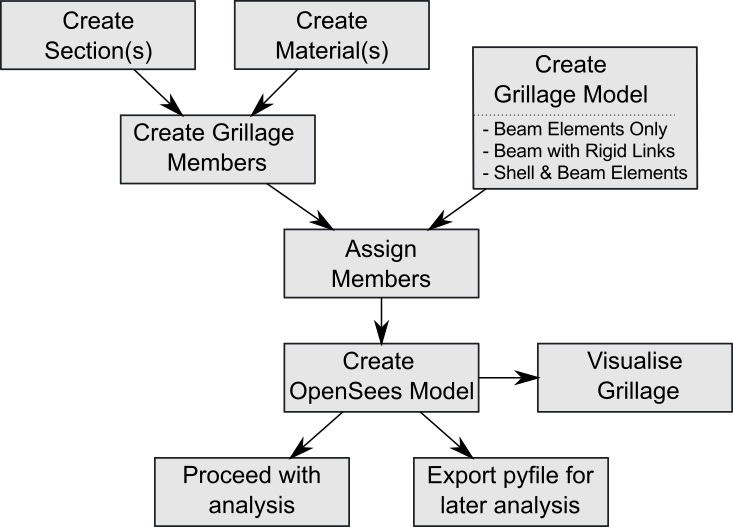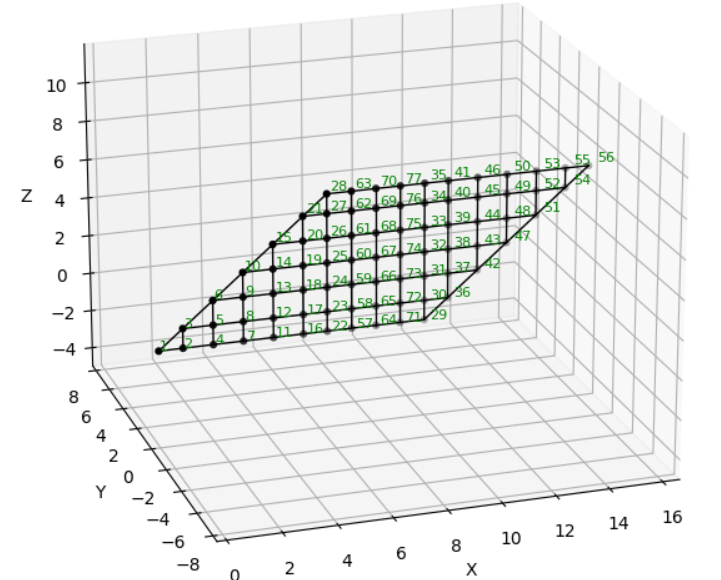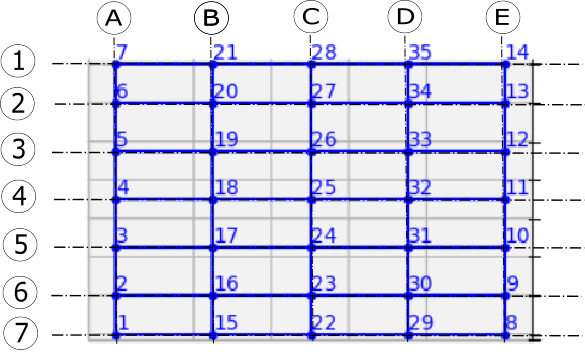Creating grillage models#
The ospgrillage module contains interface functions which can be called following the module syntax.
These interface functions generally have set_, create_ or get_ in their syntax.
For example, create_material() creates a material object for the grillage model.
A list of all interface functions can be found in API reference. Although users can opt to interact with module objects directly, we recommend the more pythonic interface functions.
Workflow overview#
Figure 1 summarizes the workflow of creating a grillage model using ospgrillage.

Figure 1: Grillage model creation flow chart#
In general, there are three steps to create a grillage model with ospgrillage:
Creating the grillage members.
Creating the grillage model object.
Assigning the defined grillage members to the elements of grillage model object.
We will detail these steps by creating a grillage model of a bridge deck as shown in Figure 2.

Figure 2: Grillage model created using OpenSeesPy#
To begin, import ospgrillage as either ospg or og as shown in the following code block.
As will be needed later, we also prepared the unit convention of variables for this example as shown in the same code block.
import ospgrillage as og
# create unit signs for variables of example
kilo = 1e3
milli = 1e-3
N = 1
m = 1
mm = milli * m
m2 = m ** 2
m3 = m ** 3
m4 = m ** 4
kN = kilo * N
MPa = N / ((mm) ** 2)
GPa = kilo * MPa
Defining elements of grillage model#
A grillage element is created using the create_member() interface function.
This function returns a GrillageMember object,
which requires two other objects as inputs, namely:
The following example code instantiates an I_beam grillage element to represent some intermediate concrete I-beam, with material and section definitions explained later on.
I_beam = og.create_member(member_name="Intermediate I-beams", section=I_beam_section, material=concrete)
The member_name string input is optional.
When setting up grillage members, it is often a good idea to first instantiate a Section
and Material class objects before creating
each GrillageMember class objects.
For the example bridge of Figure 2, lets define all its elements i.e. slab, edge_beam, and edge_slab.
slab = og.create_member(member_name="concrete slab", section=slab_section, material=concrete)
edge_beam = og.create_member(member_name="edge beams", section=edge_beam_section,material=concrete)
edge_slab = og.create_member(member_name="edge slab", section=edge_slab_section,material=concrete)
Creating material objects#
The Material object is created using create_material().
The following code line creates the concrete material needed in`defining Grillage member`_ previously.
concrete = og.create_material(material="concrete", code="AS5100-2017", grade="50MPa")
Users can choose between steel or concrete material - by passing
keyword “steel” or “concrete” argument to create_material().
Users can specify properties of steel and concrete by passing its respective keyword argument to create_material().
In addition, ospgrillage offers a library of codified material properties for steel and concrete to be selected.
At the moment, it has library for two code namely the Australia standard AS5100 and AASHTO LRFD-8th.
The following example creates the required concrete material for the example bridge.
concrete = og.create_material(E=30*GPa, G = 20*GPa, v= 0.2)
The Material object wraps OpenSees material commands, and selects appropriate OpenSees material model to represent the material.
Presently, Concrete01 and Steel01 of OpenSees library are used to represent most concrete and steel material respectively.
Other material model can be found in OpenSees database for concrete and steel.
Creating section objects#
The Section object for defining Grillage member is created using
create_section() function.
The following code line creates the Section object called I_beam_section,
which is earlier passed as input for its corresponding I_beam GrillageMember object:
I_beam_section = og.create_section(A=0.896*m2, J=0.133*m4, Iy=0.213*m4, Iz=0.259*m4, Ay=0.233*m2, Az=0.58*m2)
The module’s Section object wraps
OpenSees element command.
The following codes creates the sections for the other grillage elements specified previously:
edge_beam_section = og.create_section(A=0.044625*m2,J=2.28e-3*m4, Iy=2.23e-1*m4,Iz=1.2e-3*m4, Ay=3.72e-2*m2, Az=3.72e-2*m2)
edge_slab_section = og.create_section(A=0.039375*m2,J=0.21e-3*m4, Iy=0.1e-3*m2,Iz=0.166e-3*m2,Ay=0.0328*m2, Az=0.0328*m2))
For transverse members, there is an option to define unit width properties.
This is done by passing True to keyword argument unit_width.
When enabled, ospgrillage will automatically assigns these properties of slab section based on the spacing of transverse members.
slab_section = og.create_section(A=0.04428*m2, J=2.6e-4*m4, Iy=1.1e-4*m4, Iz=2.42e-4*m4,Ay=3.69e-1*m2, Az=3.69e-1*m2, unit_width=True)
Note
unit width is required when creating grillages with skewed angle edges.
For release 0.1.0, Non-prismatic members are currently not supported.
Creating the grillage model#
After creating the grillage elements, users create the grillage model using create_grillage() interface function.
Presently, grillage models typically represent a simply-supported beam-and-slab bridge deck. The model comprises of standard grillage members which includes:
Two longitudinal edge beams
Two longitudinal exterior beams
Remaining longitudinal interior beams
Two transverse edge slabs
Remaining transverse slabs
Figure 3 illustrates these standard grillage members and their position on an exemplar orthogonal grillage mesh.

Figure 3: Standard elements supported by ospgrillage#
Supports are automatically set at nodes along grid A (2 to 6) and grid E (9 to 13) as pinned and roller respectively.
The OspGrillage class takes the following keyword arguments:
bridge_name: Astrof the grillage model name.long_dim: Afloatof the longitudinal length of the grillage model.width: Afloatof the transverse width of the grillage model.skew: Afloatof the skew angle at the ends of grillage model.
This variable can take in a list of of 2 skew angles - this in turn creates the grillage model having edges with different skew angles.
Moreover, it is limited to \(\arctan`(``long_dim`\)/width) - num_long_grid: An int of the number of grid lines along the longitudinal direction - each grid line represents the total number of longitduinal members.
Lines are evenly spaced, except for the spacing between the edge beam and exterior beam
- num_trans_grid: An int of the number of grid lines to be uniformly spaced along the transverse direction - each grid line represents the total number of transverse members.
- edge_beam_dist: A float of the distance between exterior longitudinal beams to edge beam.
- mesh_type: Mesh type of grillage model.
- ext_to_int_dist: A float of the distance between exterior longitudinal beams to adjacent interior beams.
Must take a str input of either “Ortho” or “Oblique”.
The default is “Ortho” (an orthogonal mesh).
However, “Ortho” is not accepted for certain skew angles.
The threshold for orthogonal mesh is greater than 11 degree- less than 11 degree the mesh will change to Oblique
Figure 4 shows how the grid numbers and skew angles affects the output mesh of grillage model.

Figure 4: Example grid numbers and edge angles#
For the example bridge in Figure 2, the following code line creates its OspGrillage object i.e. example_bridge:
example_bridge = og.create_grillage(bridge_name="SuperT_10m", long_dim=10, width=5, skew=-21,
num_long_grid=7, num_trans_grid=17, edge_beam_dist=1, mesh_type="Ortho")
Coordinate System#
In an orthogonal mesh, longitudinal members run along the \(x\)-axis direction and transverse members are in the \(z\)-axis direction. Vertical (normal to grid) loads are applied in the \(y\)-axis.
Assigning grillage members#
The GrillageMember objects are assigned to the grillage model using OspGrillage object’s
set_member() function.
In addition to a GrillageMember argument, the function requires a member name string argument.
The member string specifies the standard grillage element for which the GrillageMember is assigned.
Table 1 summarizes the name strings available for ospgrillage.
Grillage name String |
Description |
|
Elements along x axis at top and bottom edges of mesh (z = 0, z = width) |
|
Elements along first grid line after bottom edge (z = 0) |
|
Elements along first grid line after top edge (z = width) |
|
For all elements in x direction between grid lines of exterior_main_beam_1 and exterior_main_beam_2 |
|
Elements along z axis where longitudinal grid line x = 0 |
|
Elements along z axis where longitudinal grid line x = Length |
|
For all elements in transverse direction between start_edge and end_edge |
The following example assigns the interior main beams of the grillage model with the earlier object of intermediate concrete I-beam:
example_bridge.set_member(I_beam, member="interior_main_beam")
For the example in Figure 1, the rest of grillage elements are assigned as such:
example_bridge.set_member(I_beam, member="interior_main_beam")
example_bridge.set_member(I_beam, member="exterior_main_beam_1")
example_bridge.set_member(I_beam, member="exterior_main_beam_1")
example_bridge.set_member(edge_beam, member="edge_beam")
example_bridge.set_member(slab, member="transverse_slab")
example_bridge.set_member(edge_slab, member="start_edge")
example_bridge.set_member(edge_slab, member="end_edge")
For orthogonal meshes, nodes in the transverse direction have varied spacing based on the skew edge region. The properties of transverse members based on unit metre width is required for its definition section properties. The module automatically implement the unit width properties based on the spacing of nodes in the skew edge regions.
The module checks if all element groups in the grillages are defined by the user. If missing element groups are detected, a warning message is printed on the terminal.
The OspGrillage class also allows for global material definition - e.g. an entire bridge made of the same
material.
To do this, users run the function set_material() passing the Material class object as the
input.
example_bridge.set_material(concrete)
This is a useful tool for switching all grillage members to the same material after previously defining with perhaps a different material.
Creating/exporting OpenSees Model#
Only once the OspGrillage is created and members are assigned, we can either:
create the model in OpenSees software space for further grillage analysis, or;
export an executable python file that can be edited and used for a more complex analysis.
These are achieved by calling the create_osp_model() function.
The create_osp_model() function takes a boolean for pyfile= (default is False).
Setting this parameter to False creates the grillage model in OpenSees model space.
example_bridge.create_osp_model(pyfile=False)
After model is instantiated in OpenSees, users can run any OpenSeesPy command (e.g. ops_vis commands) within the current workflow to interact with the OpenSees grillage model.
When pyfile= parameter is set to True, an executable py file will be generated instead. The executable py file contains all relevant OpenSeesPy command from which when executed, creates the model instance in OpenSees which can edited and later used to perform more complex analysis. Note that in doing so, the model instance in OpenSees space is not created.
Visualize grillage model#
To check that we created the model in OpenSees space, we can plot the model using OpenSeesPy’s visualization module ops_vis. The ospgrillage module already imports the ops_vis module. Therefore, one can run access ops_vis by running the following code line and a plot like in Figure 2 will be returned:
og.opsplt.plot_model("nodes") # using Get Rendering module
og.opsv.plot_model(az_el=(-90, 0)) # using osp_vis
Whilst all nodes will be visualized, only the assigned members are visualized. This is a good way to check if desired members are assigned and hence, shown on the plot. Failure to not have all members assigned will affect subsequent analysis.
Here are more details of ops_vis module